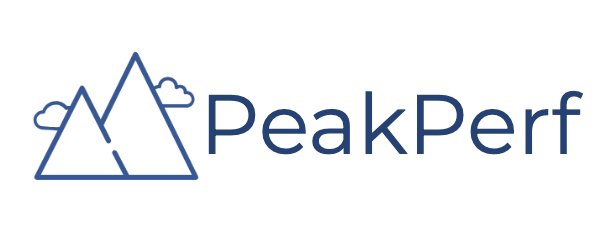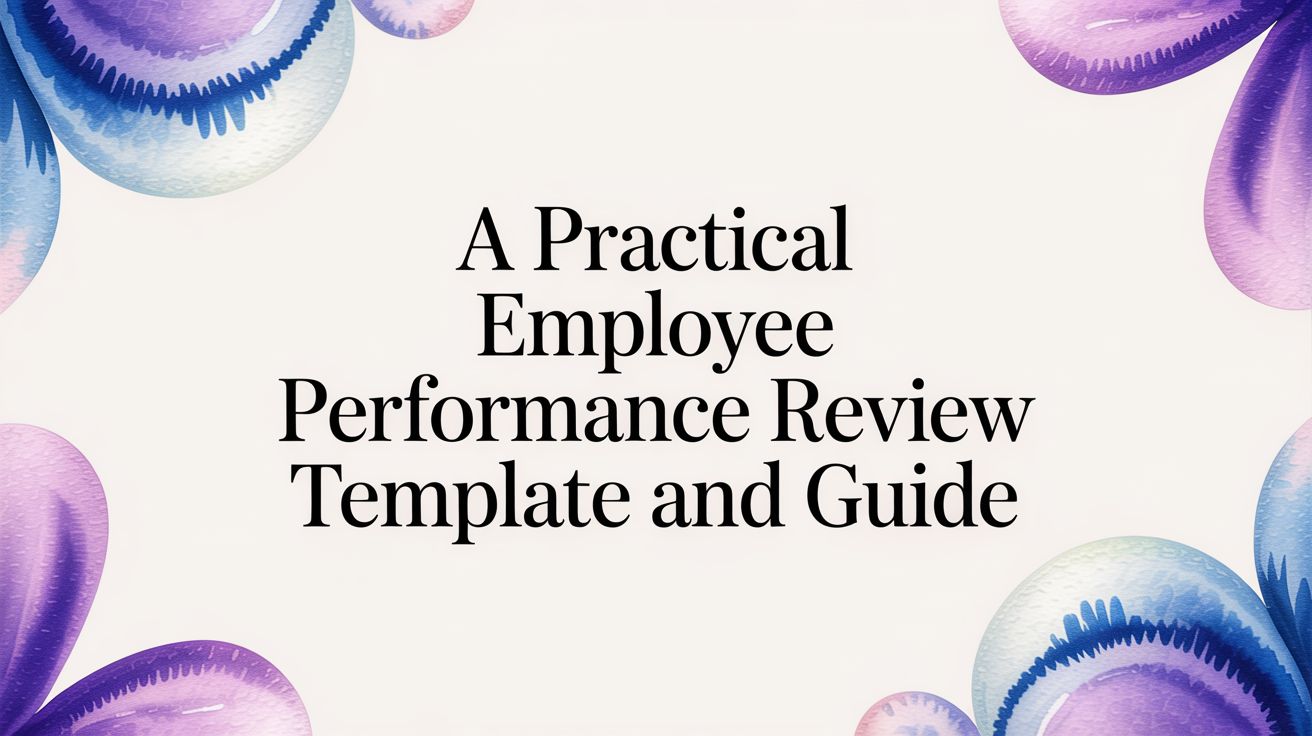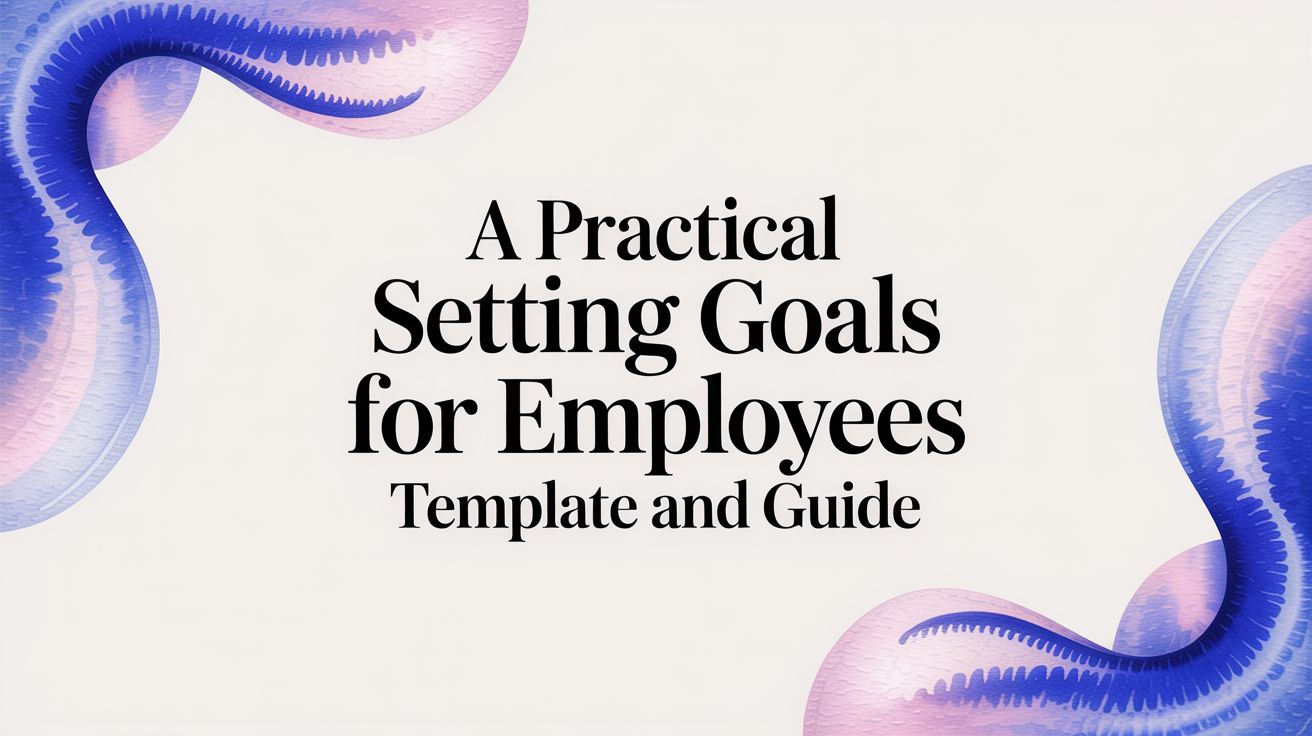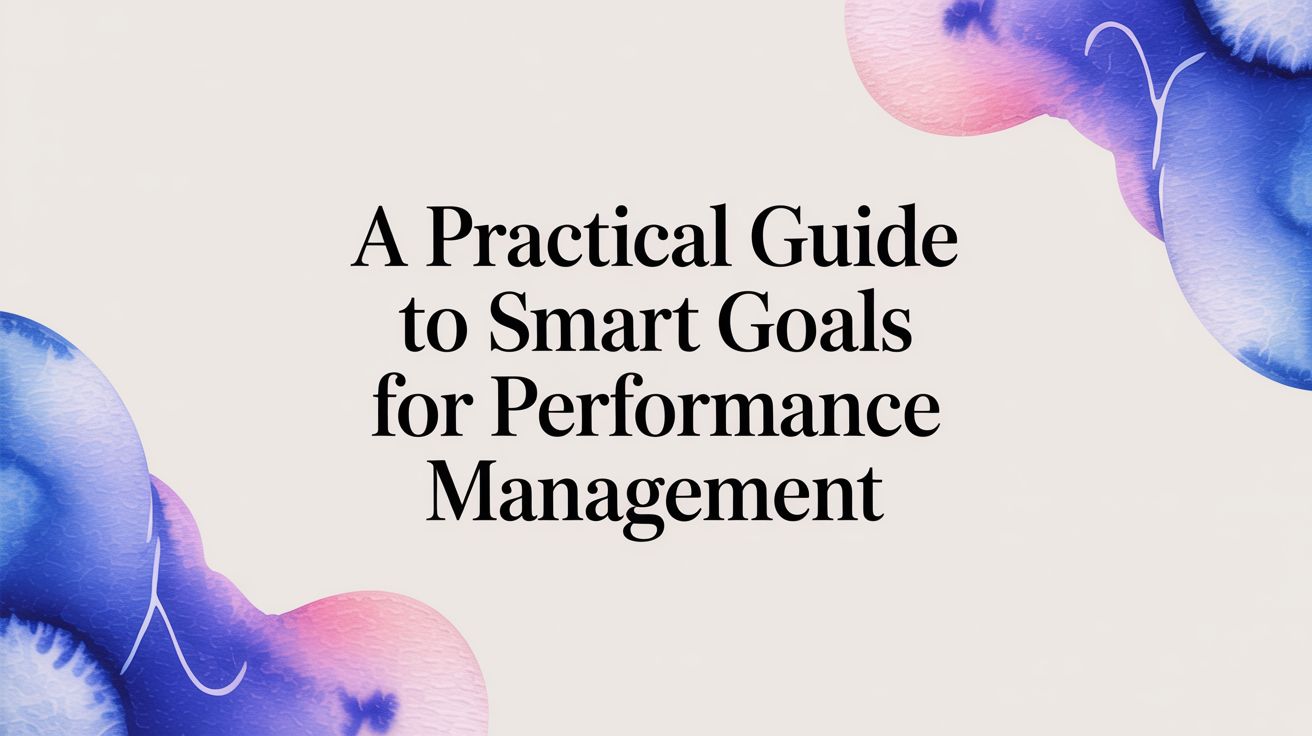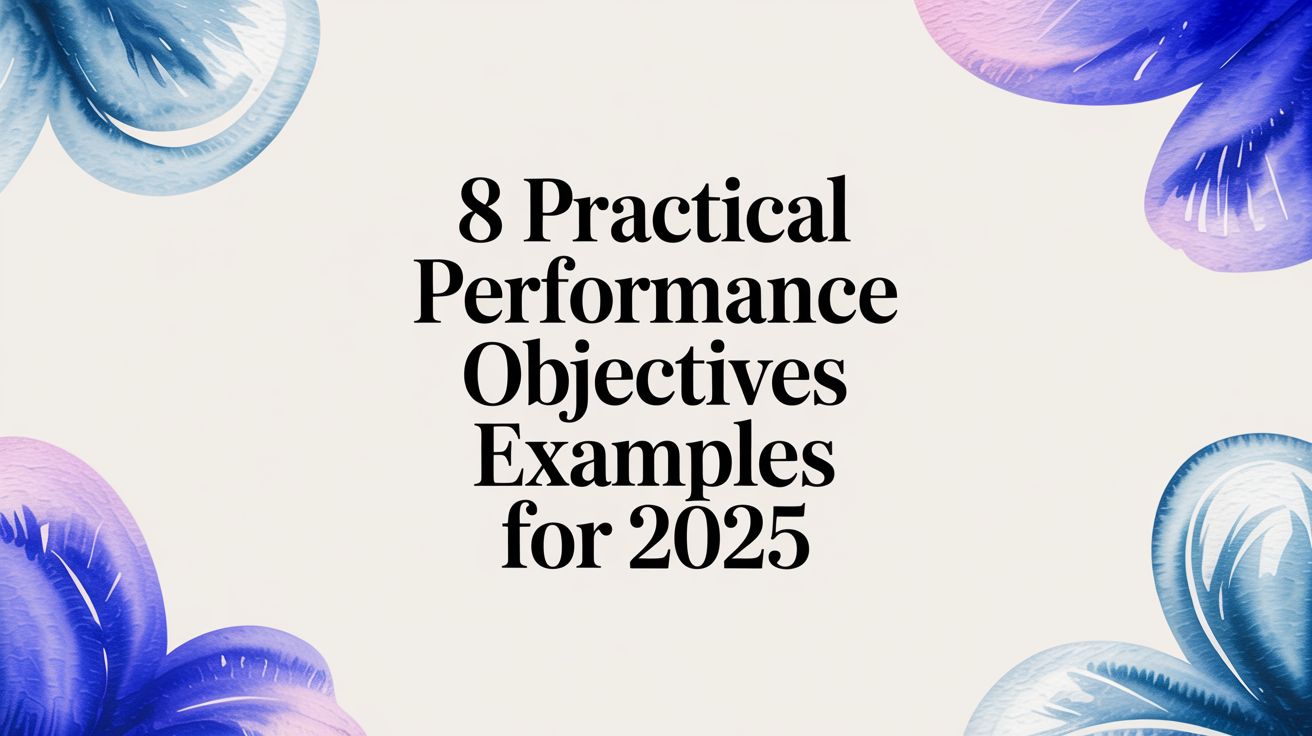How to Write a Performance Improvement Plan
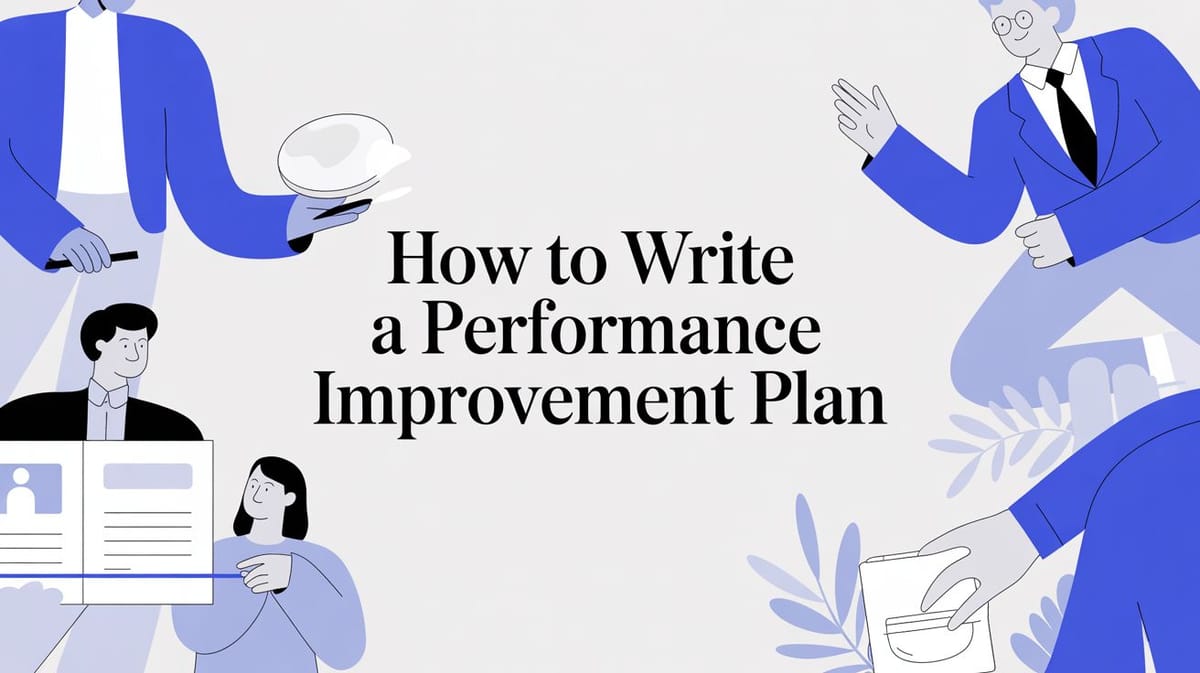
A Performance Improvement Plan (PIP) is a misunderstood management tool. People often see it as the first step toward termination. This is a missed opportunity.
A good PIP is a structured effort to help an employee succeed. It is a formal way to say, "We see a gap, and we want to help you close it." It lists specific performance issues. It sets clear expectations. It provides a framework of support.
What a Performance Improvement Plan Is
Think of a PIP as a formal roadmap for a struggling employee. It helps get them back on track. A thoughtful PIP is not a signal of an exit. It is a sign you are investing in that person's potential.
The point is to bridge the gap between an employee’s current performance and their required performance. This is a two-way process. The employee gets a transparent, fair chance to improve. The company gets a chance to retain someone with institutional knowledge.
A well-executed PIP is a tool for support and alignment. It turns ambiguous feedback into concrete actions. It gives an employee a genuine chance to meet clear standards and succeed in their role.
Most managers dread this process. They see it as an awkward task that will end badly. If you reframe the PIP as a supportive mechanism, the dynamic shifts. It becomes a foundation for a constructive dialogue, not a disciplinary hearing. A good PIP builds trust by showing your people you are committed to their growth.
Define the Core Purpose
Before you write a PIP, you must be clear on its strategic function. This is not the start of the conversation. It is the formalization of conversations from informal feedback and one-on-ones. The plan removes confusion about the seriousness of the performance issues.
A solid PIP must accomplish four things:
- Identify Deficiencies: Be specific. Pinpoint the exact areas where performance falls short.
- Set Clear Expectations: Define what success looks like with measurable goals. No guesswork is allowed.
- Provide Support: Outline the resources, training, or coaching the company will offer.
- Establish a Timeline: Create a specific, reasonable timeframe for the employee to show improvement.
This structure helps the employee. It also ensures fairness and consistency across the organization. It documents the company’s efforts to help, which is important for morale and legal protection.
The Modern Context of Performance Management
The way we manage performance is changing. A recent global survey showed nearly all companies have a formal performance management system. Yet 80% redesigned theirs in the last four years. This shift reflects a push for more effective, human-centered methods.
Traditional annual goal-setting is common. It often fails to connect what an individual does with company objectives. Only about one-third of organizations have a structured goal cascade. This disconnect makes clear tools like PIPs more important than ever. You can read more about the evolution of performance management to see where the industry is heading.
First, Gather the Facts
A Performance Improvement Plan needs to be built on facts. Your personal frustration has no place in this document. The point is to create a plan based on specific, observable, and documented evidence.
This is not just about being fair. It is about being effective. A PIP grounded in facts is defensible, clear, and helpful. A plan based on vague feelings will fail and create more problems.
Before you start writing, you need to find concrete examples of underperformance. This is the most critical part of the process.
Start digging through existing documentation. You are looking for patterns of behavior or performance gaps that are measurable and specific.
- Past Performance Reviews: What was said six months ago? Look for previously identified areas for improvement or ratings that support the current issues.
- One-on-One Meeting Notes: Your regular check-in notes should show you have already given feedback on this issue. This demonstrates you are not ambushing the employee.
- Project Data and KPIs: Numbers do not lie. Point to missed sales quotas, overdue project milestones, low customer satisfaction scores, or high error rates.
- Email and Slack Threads: Scan communications that document missed deadlines, client complaints, or instances where your instructions were not followed.
This evidence transforms the conversation from a subjective "I feel you are underperforming" to an objective "Here are three specific examples from last quarter where project deadlines were missed by more than a week."
Find the Root Cause
With your evidence in hand, the next step is to figure out why the poor performance is happening. Pointing out the problem without understanding its source is ineffective.
Poor performance is a symptom of a deeper issue.
Is it a skill deficit? The employee might not know how to do what you are asking. For example, they might struggle with a new software platform. In this case, a training plan is the core of your solution.
Is it a motivation problem? An employee might be disengaged, burnt out, or feel disconnected from the team's mission. This often appears as missed deadlines or a lack of initiative. The PIP needs to focus on reconnecting their work to team goals and clarifying the impact of their contributions.
Or is it a misunderstanding of expectations? It is easy to assume your instructions are clear when they might not be. An employee sometimes does not understand what success looks like in their role. The PIP must clarify job duties and define success metrics.
Identifying the 'why' is everything. A PIP addressing a skill gap with motivational goals is a waste of time. Your diagnosis determines the prescription.
Partner with HR from the Start
Do not write a PIP in a vacuum. Your first call should be to your Human Resources partner. This is a non-negotiable step. It protects the employee, you, and the company. Think of HR as the sanity check for the process.
HR will ensure your plan is fair, consistent with company policy, and legally sound. They will review your language to remove bias or subjective phrasing. They also have a broad view to confirm your expectations are reasonable for the employee's role and level.
This partnership is also about consistency. HR knows how PIPs are used across the organization. This helps avoid claims of discrimination by ensuring similar situations are treated in a similar way.
I once saw a manager at a startup issue a PIP without HR review. It was filled with subjective language like "needs to show more initiative" and "improve attitude." The employee challenged it. Without objective data or HR's backing, the manager had to retract the plan. It undermined his credibility.
Do not be that manager. Always partner with HR before you proceed.
Building the Core Sections of the PIP
After you do your homework and gather the facts, it is time to build the Performance Improvement Plan. A solid PIP is not one document. It is made of key sections that work together to create a clear, fair, and legally sound roadmap.
First, you must state the problem. Here, you lay out the specific performance deficiencies. This is not the time for fuzzy feedback. You need to use the concrete, fact-based examples you collected. Show the gap between the employee's current state and the required state.
This part of the PIP sets the tone. Be direct. Stick to the facts. Avoid subjective language. Focus only on what you can observe and measure.
Use the SBI Model for Clear Feedback
Delivering tough feedback requires precision. The Situation-Behavior-Impact (SBI) model is an effective tool for this. It is a framework to give specific feedback without feeling confrontational. It strips away judgment and focuses on the effects of someone's actions.
Here is how it breaks down:
- Situation: Pinpoint the exact context. When and where did this happen?
- Behavior: Describe the specific, observable action. Stick to what you saw or heard, not interpretations.
- Impact: Explain the consequence of that behavior on the project, the team, or the business.
Let us see it in action. Instead of saying, "You were disrespectful in the meeting," which is vague, try this:
"During the team meeting on Tuesday morning (Situation), you interrupted your colleagues three times while they were presenting their updates (Behavior). This disrupted the flow of the meeting and made it difficult for others to share their progress (Impact)."
The difference is clear. This approach gives the employee something tangible to understand and work on. Mastering the SBI model is fundamental to writing a PIP that drives change.
Try our free SBI Feedback Tool to draft your feedback in minutes. Get structured guidance and AI-powered suggestions to help you deliver clear, actionable feedback.
To map this out, the process looks like this: review the documentation, identify the performance gaps, and always consult with HR before you start writing.
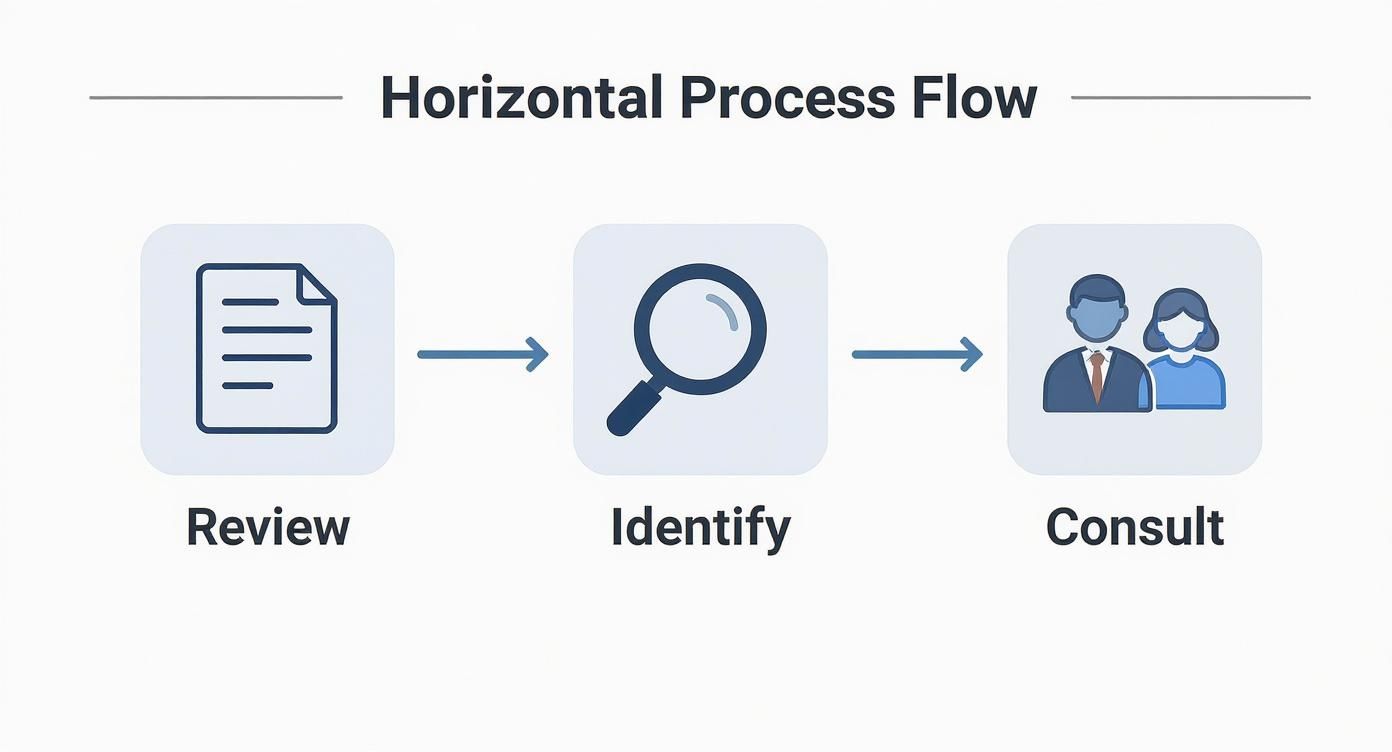
Following these steps ensures the PIP is built on objective evidence and aligns with company policies.
Set SMART Goals for Improvement
After you define the problem, you must define the solution. The heart of any good PIP is a set of SMART goals. This is how you translate expectations into a measurable action plan for the employee.
If you are not familiar, SMART stands for:
- Specific: The goal is clear. There is no room for interpretation.
- Measurable: You can track progress with data.
- Achievable: The goal is realistic and within the employee's power to meet.
- Relevant: It aligns with their role and business needs.
- Time-bound: It has a non-negotiable deadline.
A vague goal like "improve your communication" is useless. It gives the employee nothing to aim for. A SMART goal turns that fuzziness into a concrete target.
A goal without a clear metric is a wish. SMART goals remove ambiguity and create a shared understanding of success.
This is critical when you think about the overall Performance Improvement Plan Success Rate. Companies that get this right see success rates above 75%. They build their PIPs on these measurable goals and strong manager support. A low success rate is a red flag that PIPs are poorly designed. They often lack the clarity SMART goals provide.
Let's look at how to take a typical vague goal and sharpen it into a SMART goal.
Transforming Vague Goals into SMART PIP Goals
This table shows how to turn unclear performance objectives into actionable, measurable SMART goals for a PIP.
The difference is significant. One is a suggestion; the other is a clear path to success.
Define Support and State Consequences
A PIP is a two-way commitment. After you lay out the goals, you must outline the support and resources the company will provide. This shows you are invested in helping the employee succeed, not just documenting their failure.
This support might include:
- Extra training on a specific software or skill.
- Weekly one-on-one coaching sessions with you.
- A mentorship pairing with a senior team member.
- Access to new tools or resources they need.
Finally, the PIP must be honest about the consequences if the goals are not met. This section should be direct, professional, and unambiguous. You need to clearly state that failure to make the required improvements by the deadline may lead to further disciplinary action, up to and including termination of employment.
This is a tough message to deliver, but clarity is crucial. It ensures the employee understands the seriousness of the situation. It leaves no room for surprises.
Creating a Clear Timeline for Improvement
A Performance Improvement Plan without a clear timeline is a list of suggestions. To have any effect, the plan needs a firm start and end date. This structure creates a sense of urgency. It gives everyone a defined window for measuring progress.
The duration of a PIP is not one-size-fits-all. It has to be long enough for the employee to absorb feedback and show change. It must be short enough to keep the pressure on. Most PIPs run between 30 and 90 days.
A 30-day plan can work for correcting straightforward behavioral issues or a minor skill gap. For more complex performance problems, a 90-day plan is more realistic. Your job is to pick a duration that matches the scope of the needed improvements.
Establish Key Milestones and Check-In Dates
Once you set the total duration, you must break it down. A 90-day goal can feel overwhelming. Milestones and regular check-ins chop it up into smaller, manageable parts. This creates a rhythm of accountability.
Schedule these check-ins from the beginning. Get them on the calendar immediately. This sends a signal that you are committed to the process.
These meetings are non-negotiable. They are the engine of the PIP. Here, you provide real-time feedback, adjust tactics, and track progress against the SMART goals. This turns the PIP from a static document into a living coaching tool.
A timeline with scheduled check-ins removes ambiguity. It forces consistent communication and ensures neither you nor the employee can forget it.
For a typical 60-day PIP, your check-in schedule might look like this:
- Weekly Informal Check-ins: Quick, 15-minute meetings every Friday to review the week’s progress and address immediate roadblocks.
- Bi-Weekly Milestone Reviews: Formal 30-minute reviews every two weeks to dig into progress against specific goals. Document what is working and what is not.
- Mid-Point Review (Day 30): A comprehensive check-in to evaluate the first half of the plan and make any course corrections.
- Final Review (Day 60): The final meeting to determine if the PIP objectives have been met based on the evidence.
Define What Success Looks Like
How will you know if the employee has turned things around? You must define the victory conditions in clear, measurable terms. This prevents confusion when the PIP period is over.
Your success criteria should tie directly back to the SMART goals. If a goal was to reduce report errors to less than 2%, then success means hitting that metric consistently by the end date. There should be no room for subjective interpretation.
You also need to state what happens upon successful completion. This usually means the employee returns to good standing and the plan is closed. Highlighting this positive outcome reinforces the PIP as a corrective tool, not a step toward the exit.
The Importance of Meticulous Documentation
Throughout the PIP timeline, documentation is essential. This is not just for legal protection. It is about running a fair, transparent, and objective process for the employee.
Your notes must be factual and unemotional. For every check-in, record the date, what you discussed, and the specific outcomes. Note both progress and setbacks with concrete examples.
For instance, a weak entry might say, "Employee had a better attitude this week." A strong, defensible entry would state, "Employee successfully submitted all three weekly reports on time and with zero errors, meeting the goal for this milestone."
This detailed record creates a clear story of the employee's journey. If you get to the final review and the goals have not been met, your documentation will show you provided consistent support and clear feedback. It demonstrates a good-faith effort to help them improve.
Conducting the PIP Meeting and Follow-Up
The written plan is only half the battle. How you deliver the Performance Improvement Plan is as important as what is in it. This one meeting sets the tone for the weeks ahead.
Your job here is to be calm, professional, and direct. Find a private, neutral space where you will not be interrupted. Try to avoid scheduling this conversation at the end of the day or right before a weekend. That leaves the employee anxious.
Setting the Stage for the Meeting
Once you are in the room, get straight to the point. There is no sense in making small talk. Calmly state the purpose of the meeting. Explain that you are there to discuss their performance and walk through a plan to get them back on track.
Go through the document section by section. Talk through the specific performance gaps. Review the SMART goals you have set. Lay out the support you are committing to. Remember, this is a conversation, not a lecture.
After you explain a section, pause. Ask what questions they have. It is vital they understand every part of the plan. You need to listen to their feedback or concerns without getting defensive.
Managing their reaction is a huge part of this. They might be surprised, upset, or angry. Your job is to stay professional and empathetic but firm on the core issues. Keep circling back to the purpose: this is about improvement, not punishment.
The Follow-Up Is Non-Negotiable
A PIP is a living document, not a task you check off your to-do list. The follow-up period is where the real work happens. Consistent, scheduled check-ins are the most critical element of a successful plan.
You must stick to the check-in schedule you defined in the plan. These meetings are your chance to provide real-time coaching, give feedback, and show your support. They also establish a rhythm of accountability.
A PIP without consistent follow-up sends a clear message that the plan is not a priority. It undermines the entire process and makes it harder for the employee to succeed.
During each check-in, stick to the facts. How are they progressing against the specific goals? Use the SBI model to give precise, actionable feedback on recent performance. If you need a refresher, you can explore our detailed guide on the Situation-Behavior-Impact model to help frame your conversations.
Documenting Every Step
Meticulous documentation must continue through the entire follow-up period. After each check-in meeting, write up a brief, factual summary of your conversation. Note any progress, ongoing challenges, and specific examples you discussed.
This documentation does two things. First, it creates a clear record of the employee’s journey and the support you provided. Second, it protects the company by showing a fair and consistent process was followed.
Keep your notes objective and free of emotion. Focus on observable behaviors and measurable outcomes. For example, instead of writing "had a better week," you would write, "Submitted two of three reports on time, an improvement from zero the previous week."
A structured PIP process delivers real business results. One case study of a mid-sized firm found productivity rose from 65% to 85% in a single year after they implemented PIPs with targeted training. This mirrors broader findings that companies investing in employee development see profit margins 24% higher than those that do not.
Unpacking Common Questions on Performance Improvement Plans
When you first learn how to write a PIP, it is natural to have questions. The process can feel heavy and complicated. Let's walk through common concerns managers have so you can move forward with clarity.
Is a PIP the First Step to Getting Fired?
No. Or at least, it should not be. A PIP is a genuine, structured effort to help a struggling employee get back on track. The real goal is recovery, not removal. While termination is a possible outcome, the intent of the plan must be corrective.
When you build a plan with clear, achievable goals and provide real support, many employees turn things around. A well-documented process also protects the company if termination becomes the only option. It shows you followed a fair and supportive procedure.
A PIP is a tool for support and course correction. Viewing it only as a path to termination misses its primary purpose of retaining and developing your team members.
When an employee successfully completes a PIP, they return to good standing. This outcome is a win. It reinforces the plan as a developmental tool and builds trust by showing you are committed to helping your people succeed.
What Are the Biggest Legal Mistakes to Avoid?
The legal landmines are usually in three areas: inconsistency, subjectivity, and poor documentation. Sidestepping these is critical.
The biggest red flag is inconsistency. Applying PIPs to some employees but not others for similar issues is a direct path to a discrimination claim. Fairness must be systematic.
Next, keep your feedback grounded in objective, measurable facts, not personal feelings. Vague statements like "needs a better attitude" are unhelpful and legally risky. Instead, use specific, data-driven examples of behavior and its impact on the business.
Finally, documentation is essential. Document every step: the initial meeting, each follow-up conversation, and the final outcome. This written record is your most crucial asset if you need to defend the company’s actions. Always loop in HR to ensure your plan is compliant and aligned with company policy.
How Should I Handle an Employee Who Refuses to Sign?
First, stay calm. An employee’s signature on a PIP acknowledges they have received the document. It does not mean they agree with everything in it.
If they refuse to sign, explain that their signature is for receipt confirmation. If they still refuse, make a note on the document. Something simple like, "Employee received a copy of this plan on [Date] but declined to sign."
For extra backup, have an HR representative witness the conversation and sign the document, noting the employee's refusal. The plan is in effect whether they sign or not. The process does not stop because of a missing signature, as long as you document their refusal.
What Is the Manager's Role During the PIP Period?
Your job is to be an active coach, not a passive observer. Your engagement is what makes or breaks the process.
This means you must provide the resources you promised in the plan. This could be extra training, new tools, or mentorship from a senior colleague. This shows you are invested in their success.
You also must follow through on your check-ins. These are not just status updates. They are opportunities to give timely feedback, troubleshoot roadblocks, and make adjustments.
Your role is a balancing act. You must support their efforts while also holding them accountable to the plan’s goals. A disengaged manager sends a clear signal that the PIP is not a priority, which undermines the effort. Your active participation is non-negotiable.
You can find more resources and tools to support your management practices by exploring what PeakPerf has to offer.
Are you preparing for a difficult conversation with an employee? PeakPerf is a management toolbox that helps you prepare for tough leadership moments in minutes. Go from a blank page to a structured, professional draft for feedback, reviews, and development plans using proven leadership frameworks.
